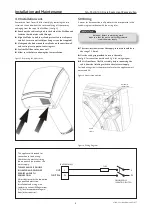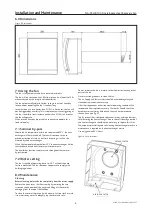
4.0 Installation cont.
Remove the Front Cover / Baffle assembly by removing the two
screws on the underside of the cover and lifting off the cover by
unhinging from the top of the Wall Box. (see fig 2.)
l
Knock out the cable entry hole in the back of the Wall Box and
feed the flexible mains cable through.
l
Align Wall Tube to hole in wall and present fan to wall square
and flat. Secure to wall with four fixing screws (not supplied).
l
Make good the hole around the wall tube on the outside wall
and seal in place to prevent water ingress.
l
Seal the Wall Box to the inner wall.
l
Allow to set before continuing the fan installation.
5.0 Wiring
A means for disconnection in all poles must be incorporated in the
fixed wiring in accordance with the wiring rules.
l
The cross-sectional area of the supply cord used should be in
the range 1-1.5mm².
l
Use the cable grip provided to secure the cable.
See fig 3. for connection position and fig 4. for wiring diagram.
l
Re-fit Front Cover / Baffle assembly before connecting the
cable from the isolating switch to the electrical supply.
For fixed wiring circuits the protective fuse for the appliance must
not exceed 5A.
2
27. 04. 15 Leaflet Number 671677
Installation and Maintenance
NA-SRHR-100 Single Room Heat Recovery Fan
Isolation - Before commencing work
make sure that the unit is electrically isolated
from the mains supply.
Figure 2. Removing the front cover.
Figure 4. Wiring diagram.
Cable
clamp
Customer
connection
Figure 3. Connection position.
FAN TERMINALS
FUSE
DOUBLE POLE
ISOLATING SWITCH
L
N
LIVE
NEUTRAL
L
N
This appliance is intended for
connection to fixed wiring.
Check that the electrical rating
shown on each fan matches the
mains supply.
THIS APPLIANCE IS DOUBLE
INSULATED AND DOES NOT
REQUIRE AN EARTH
CONNECTION.
All installations must be supervised
by a qualified electrician.
Installations and wiring must
conform to current IEE Regulations
(UK), local or appropriate regula-
tions (other countries).




